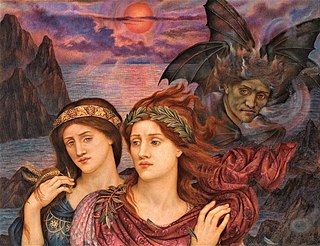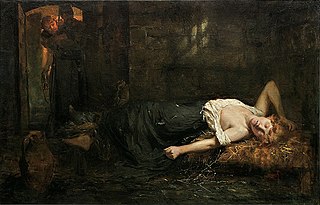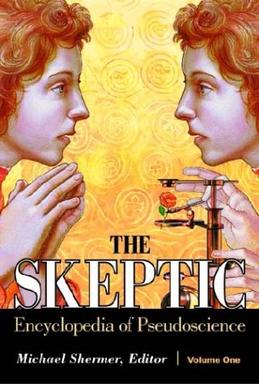
Rumpology or bottom reading is a pseudoscience akin to physiognomy, performed by examining crevices, dimples, warts, moles and folds of a person's buttocks in much the same way a chirologist would read the palm of the hand. [2]

Rumpology or bottom reading is a pseudoscience akin to physiognomy, performed by examining crevices, dimples, warts, moles and folds of a person's buttocks in much the same way a chirologist would read the palm of the hand. [2]
The term rumpology is a neologism. The late American astrologer Jackie Stallone claimed that rumpology is known to have been practiced in ancient times by the Babylonians, the Indians, and the Ancient Greeks and Romans. [3]
Rumpologists have a variety of theories as to the meaning of different posterior characteristics. According to Stallone, the left and right buttocks reveal a person's past and future, respectively, although she has also commented that "The crack of your behind corresponds to the division of the two hemispheres of the brain". [4] According to blind German clairvoyant and rumpologist Ulf Buck, an "apple-shaped, muscular bottom indicates someone who is charismatic, dynamic, very confident and often creative. A person who enjoys life. A pear-shaped bottom suggests someone very steadfast, patient and down-to-earth." [5] The British rumpologist Sam Amos claims that "A round bottom indicates the person is open, happy and optimistic in life. However, a flat bottom suggests the person is rather vain and is negative and sad." [6]
Rumpology can be performed either by sight, touch or by using buttock prints. [3] In addition to live readings, Jackie Stallone performed buttock readings using e-mailed digital photographs, [7] and has claimed to predict the outcome of Presidential elections and Oscar awards by reading the bottoms of her two pet Doberman Pinschers. [8] Ulf Buck, who is blind, claims he can read people's futures by feeling their naked buttocks. [5]

Clairvoyance is the magical ability to gain information about an object, person, location, or physical event through extrasensory perception. Any person who is claimed to have such ability is said to be a clairvoyant.

Extrasensory perception or ESP, also called sixth sense, is a claimed paranormal ability pertaining to reception of information not gained through the recognized physical senses, but sensed with the mind. The term was adopted by Duke University psychologist J. B. Rhine to denote psychic abilities such as intuition, telepathy, psychometry, clairvoyance, clairaudience, clairsentience, empathy and their trans-temporal operation as precognition or retrocognition.

Pseudoscience consists of statements, beliefs, or practices that claim to be both scientific and factual but are incompatible with the scientific method. Pseudoscience is often characterized by contradictory, exaggerated or unfalsifiable claims; reliance on confirmation bias rather than rigorous attempts at refutation; lack of openness to evaluation by other experts; absence of systematic practices when developing hypotheses; and continued adherence long after the pseudoscientific hypotheses have been experimentally discredited.

Skepticism, also spelled scepticism, is a questioning attitude or doubt toward knowledge claims that are seen as mere belief or dogma. For example, if a person is skeptical about claims made by their government about an ongoing war then the person doubts that these claims are accurate. In such cases, skeptics normally recommend not disbelief but suspension of belief, i.e. maintaining a neutral attitude that neither affirms nor denies the claim. This attitude is often motivated by the impression that the available evidence is insufficient to support the claim. Formally, skepticism is a topic of interest in philosophy, particularly epistemology. More informally, skepticism as an expression of questioning or doubt can be applied to any topic, such as politics, religion, or pseudoscience. It is often applied within restricted domains, such as morality, atheism, or the supernatural. Some theorists distinguish "good" or moderate skepticism, which seeks strong evidence before accepting a position, from "bad" or radical skepticism, which wants to suspend judgment indefinitely.

Telepathy is the purported vicarious transmission of information from one person's mind to another's without using any known human sensory channels or physical interaction. The term was first coined in 1882 by the classical scholar Frederic W. H. Myers, a founder of the Society for Psychical Research (SPR), and has remained more popular than the earlier expression thought-transference.

Fortune telling is the practice of predicting information about a person's life. The scope of fortune telling is in principle identical with the practice of divination. The difference is that divination is the term used for predictions considered part of a religious ritual, invoking deities or spirits, while the term fortune telling implies a less serious or formal setting, even one of popular culture, where belief in occult workings behind the prediction is less prominent than the concept of suggestion, spiritual or practical advisory or affirmation.

The biorhythm theory is the pseudoscientific idea that peoples' daily lives are significantly affected by rhythmic cycles with periods of exactly 23, 28 and 33 days, typically a 23-day physical cycle, a 28-day emotional cycle, and a 33-day intellectual cycle. The idea was developed by Wilhelm Fliess in the late 19th century, and was popularized in the United States in the late 1970s. The proposal has been independently tested and, consistently, no validity for it has been found.

Palmistry is the practice of fortune-telling through the study of the palm. Also known as palm reading, chiromancy, chirology or cheirology, the practice is found all over the world, with numerous cultural variations. Those who practice palmistry are generally called palmists, hand readers, hand analysts, or chirologists.
Cold reading is a set of techniques used by mentalists, psychics, fortune-tellers, and mediums. Without prior knowledge, a practiced cold-reader can quickly obtain a great deal of information by analyzing the person's body language, age, clothing or fashion, hairstyle, gender, sexual orientation, religion, ethnicity, level of education, manner of speech, place of origin, etc. during a line of questioning. Cold readings commonly employ high-probability guesses, quickly picking up on signals as to whether their guesses are in the right direction or not, then emphasizing and reinforcing chance connections and quickly moving on from missed guesses. Psychologists believe that this appears to work because of the Forer effect and due to confirmation biases within people.
Pyramid power refers to the belief that the ancient Egyptian pyramids and objects of similar shape can confer a variety of benefits. Among these assumed properties are the ability to preserve foods, sharpen or maintain the sharpness of razor blades, improve health, function "as a thought-form incubator", trigger sexual urges, and cause other effects. Such unverified conjectures regarding pyramids are collectively known as pyramidology.
Body worship is the practice of physically revering a part of another person's body, and is usually done as a submissive act in the context of BDSM. It is often an expression of erotic fetishism but it can also be used as part of service-oriented submission or sexual roleplay. It typically involves kissing, licking or sucking parts of a dominant's body such as the vulva, the penis, the buttocks, the feet, the breasts or the muscles.

Jacqueline Frances Stallone was an American astrologer, dancer and wrestling promoter. She was the mother of actor Sylvester Stallone, singer Frank Stallone, and actress Toni D'Alto, the latter by her former husband Anthony Filiti.

Buttock cleavage is minor exposure of the buttocks and the intergluteal cleft between them, often because of low-rise pants. The crena is a formal term for the cleft between the buttocks.
Gluteoplasty denotes the plastic surgery and the liposuction procedures for the correction of the congenital, traumatic, and acquired defects and deformities of the buttocks and the anatomy of the gluteal region; and for the aesthetic enhancement of the contour of the buttocks.

Dermo-optical perception (DOP) – also known as dermal vision, dermo-optics, eyeless sight, eyeless vision, skin vision, skin reading, finger vision, paroptic vision, para-optic perception, cutaneous perception, digital sight, and bio-introscopy – is a term that is used in parapsychological literature to denote the alleged capability to perceive colors, differences in brightness, and/or formed images through the skin, especially upon touching with the fingertips.

The gluteal muscles, often called glutes, are a group of three muscles which make up the gluteal region commonly known as the buttocks: the gluteus maximus, gluteus medius and gluteus minimus. The three muscles originate from the ilium and sacrum and insert on the femur. The functions of the muscles include extension, abduction, external rotation, and internal rotation of the hip joint.

A psychic reading is a specific attempt to discern information through the use of heightened perceptive abilities; or natural extensions of the basic human senses of sight, sound, touch, taste and instinct. These natural extensions are claimed to be clairvoyance (vision), clairsentience (feeling), claircognisance and clairaudience (hearing) and the resulting statements made during such an attempt. The term is commonly associated with paranormal-based consultation given for a fee in such settings as over the phone, in a home, or at psychic fairs. Though psychic readings are controversial and a focus of skeptical inquiry, a popular interest in them persists. Extensive experimentation to replicate psychic results in laboratory conditions have failed to find any precognitive phenomena in humans. Psychic reading is pseudoscience. A cold reading technique allows psychics to produce seemingly specific information about an individual from social cues and broad statements.

The Skeptic Encyclopedia of Pseudoscience is a two-volume collection of articles that discuss the Skeptics Society's scientific findings of investigations into pseudoscientific and supernatural claims. The editor, Michael Shermer, director of the Skeptics Society, has compiled articles originally published in Skeptic magazine with some conceptual overviews and historical documents to create this encyclopedia. It was published by ABC-CLIO in 2002.
Statement analysis, also called scientific content analysis (SCAN), is a technique for analyzing the words people use to try to determine if what they said is accurate. Proponents claim this technique can be used to detect concealed information, missing information, embedded confessions and whether the information that person has provided is true or false.

The buttocks are two rounded portions of the exterior anatomy of most mammals, located on the posterior of the pelvic region. In humans, the buttocks are located between the lower back and the perineum. They are composed of a layer of exterior skin and underlying subcutaneous fat superimposed on a left and right gluteus maximus and gluteus medius muscles. The two gluteus maximus muscles are the largest muscles in the human body. They are responsible for movements such as straightening the body into the upright (standing) posture when it is bent at the waist; maintaining the body in the upright posture by keeping the hip joints extended; and propelling the body forward via further leg (hip) extension when walking or running. In the seated position, the buttocks bear the weight of the upper body and take that weight off the feet.